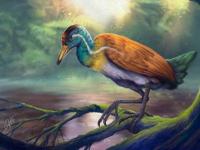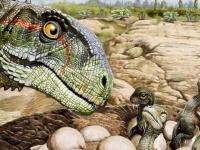Can You Really Pull a "Jurassic Park" and Extract DNA from Bugs Frozen in Amber?

So we may never actually extract the blood of a mosquito that bit a dinosaur 100 million years ago and use it to resurrect dinosaurs that take over an entire theme park, but we haven’t even been able to get a complete DNA profile from an insect frozen in amber. Yet.
Even bugs who met that unfortunate fate long after the dinosaurs went extinct are deceptive. They might appear like they were just crawling around yesterday, because tissues can be exceptionally preserved by tree resin or sap that eventually hardens and fossilizes, but this doesn't mean everything stays intact. DNA degrades too fast. It has sometimes been found in things as bizarre as ancient chewing gum, but that gum was way less ancient than mosquitoes trapped in 125 million-year-old fossilized resin. These are still nothing compared to the thing that created a monster — or many monsters — in Jurassic Park, but their DNA was too far gone to study. Life finds a way, but DNA doesn’t after death.
“It is doubtful that DNA stays preserved for a long time inside the resin,” paleontologist David Peris, who led a study recently published in PLOS ONE, told SYFY WIRE. "The permeability of resin, especially in hydrated conditions, makes it a non-viable environment for preserving organic molecules."
While they won’t be bringing back any Velociraptors, a team of scientists are now pushing the limit to find out how long DNA can last in a specimen like the one John Hammond was so thrilled about. More has survived in dinosaur fossils and animals frozen in permafrost than creatures caught in tree resin. Amber and other resins have proven to be nowhere near as successful at preserving the genetic code of a beetle or mosquito as they are at preserving the organism itself, and possible contamination doesn't help, but updated methods and technology could eventually find out a DNA expiration date that could help figure out the mysteries of ancient DNA (aDNA).
Prehistoric DNA can give scientists a look back in time to see how something evolved on a molecular level and how its relationships with other life-forms changed over millennia. It can also determine both extinct and extant species that an extinct organism could be related to. To figure out how soon it is before genetic information starts degrading, Peris and his team collected samples of beetles that had only just succumbed to being stuck in tree resin 3 to 6 years ago. That might sound far from anything prehistoric, but since nobody can travel millions of years back in time to when fossil bugs were first caught in the ooze, it is an opportunity to trace the beginnings of the process of DNA degradation in amber specimens.
"Ancient DNA will be highly degraded and incomplete, and it depends on the preservation state (ancient DNA may be better preserved than some current DNA if conditions are favorable or not)," Peris said. "This is why it is important to demonstrate what the identified DNA is from. In our case, we compared the sequences with our fresh specimens in order to demonstrate that they were from beetles, but from different ones than our fresh specimens."
Unlike that huge needle that went right through the amber and into the mosquito in that iconic scene from Jurassic Park, extracting DNA from fossilized insects in amber often involves soaking the sample in chloroform to free the inset before grinding up samples to examine under a microscope. The researchers found out this only fast-forwards the degradation process. DNA starts breaking apart almost immediately after death. Amber that has survived a hundred million years has already gone through enough.
Many factors can have an impact on the DNA of the bug inside, from the conditions under which it was preserved to how quickly the specimen was buried to geological phenomena that happened up until it was unearthed. There is one rare exception to bugs whose looks can deceive scientists into thinking their DNA has held up as long as their appearance. Sometimes, an insect is mummified fast enough to freeze the degradation process, with DNA being absorbed by minerals as its tissues desiccate. If that glob of amber is buried quickly afterwards, that can offer even more protection. The ancient Egyptians obviously knew what they were doing by desiccating a body with natron salts and then covering it in oils and resins.
Unfortunately, this accidental and immediate mummification is rare in amber specimens.
"Our experiment demonstrates the contrary situation," Peris said. "Our specimens were not dehydrated after some years inside the resin, but still kept fresh internal tissues. This situation is exactly what makes the conservation of organic molecules difficult, since hydration favors the oxidation of these molecules. In additoin, amber and resin have proven to be highly permeable."
When geological processes make amber more permeable, anything caught inside is subject to quicker DNA degradation, not to mention contamination from the DNA of other organisms that might be found in the soil. This explains all the errors in thinking the genes extracted from an ancient mosquito in amber all belong to that mosquito, when they could belong to anything.
Peris believes that certain measures are required to get the most DNA out of an insect in amber. The sample should be analyzed in a DNA lab that has had previous experience with aDNA, but has not studied organisms similar to the specimens in question. Studying a species that has often been found fossilized in amber also helps. There should be controls as a basis for comparison, including those whose DNA cannot be amplified enough for study. There should also be a specialized approach to amplifying DNA that fits just that organism’s genome as opposed to one that fits many different genomes, and repetitions of the experment as well as a sequencing analysis are needed to back-check.
"We demonstrated that DNA can be preserved inside resin for some years, at least, but detected that conditions are not favorable to guarantee that he situation stayed that way for a long time," he said. "We must now begin to intestigate why that is, exactly how long the time limit is, and if it is the general situaiton; we have just started exploring it."
While Peris is somewhat optimistic about the future of studying DNA extracted from resin specimens, Hammond would be disappointed. His experiments would have probably reached a dead end. If he couldn’t even get most of the DNA out of a mosquito that could have bitten a dinosaur, there is no way his dream park would ever come roaring to life.
Source: www.syfy.com/








